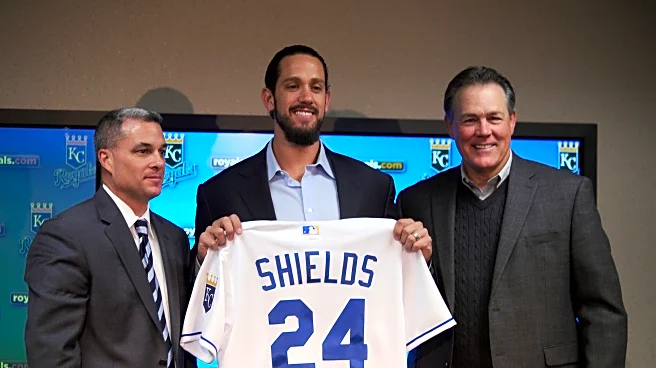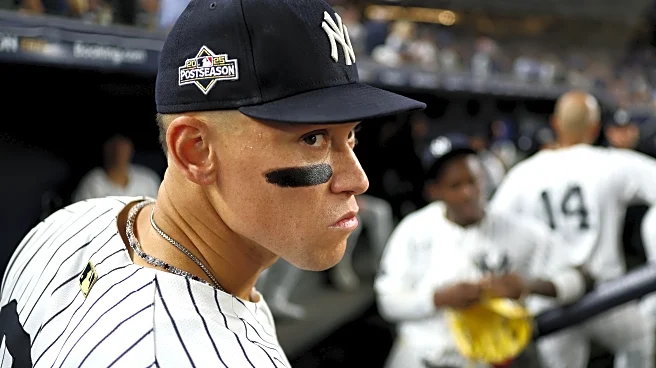Welcome back to BCB After Dark: the coolest club for night owls, early risers, new parents and Cubs fans abroad. Please come on in and sit with us. If you need anything, let us know. We can check your
coat for you. There are still a few tables available. The hostess will seat you now. Bring your own beverage.
BCB After Dark is the place for you to talk baseball, music, movies, or anything else you need to get off your chest, as long as it is within the rules of the site. The late-nighters are encouraged to get the party started, but everyone else is invited to join in as you wake up the next morning and into the afternoon.
Last week, I asked you if you had any interest in the Cubs trading for Angels outfielder Jo Adell. Thirty-nine percent of you wanted to stay away from Adell at any reasonable cost. Another 34 percent thought Adell would be a good pickup at a low price and 27 percent think the Cubs should pull the trigger on an Adell trade.
Here’s the part where we listen to music and talk movies. The BCB Winter Science Fiction Classic moves into the “New Hollywood” phase tonight. But you’re always free to skip these sections.
When picking music to share, sometimes I just pick something I heard earlier in the day. Sometimes I just pick something that got tossed at me in my YouTube feed. Sometimes I try to find something different that will expand your horizons. Sometimes I just grab something that randomly popped into my head during the day.
But sometimes, I just need a crowd pleaser. Tonight is one of those nights. So here is the Pacific Jazz Orchestra playing Quincy Jones’ “Ironside.” This was just recorded last month.
So if you look at the final vote totals from last week’s matchup in the BCB Winter Science Fiction Classic, it says that number-eight seed The Time Machine beat the number-one seed The Day the Earth Stood Still. But I went and checked the votes and one person (or at least the same IP address) voted for The Time Machine 71 times.
Folks, don’t do that. It’s not that important and you’re just trying to impose your tastes on everyone else. Luckily it was only one person who did that—there were some other IP addresses that voted twice, but I’m going to assume that’s just two people in the same house and that’s completely fine and encouraged—but I’m not going to let one person vote 71 times when everyone else followed the rules. I’m going to try to prevent that from now on—don’t get me going on the new polling software because there are major issues with it—but please behave yourselves
So in any case, I’m moving The Day the Earth Stood Still on to the next round.
So now we move on to the “New Hollywood” bracket, or 1961 to 1976. It’s ironic that I’m calling it that, because only three of the eight films in this bracket are American. Three are French, one is British and one is from the Soviet Union.
This is the period where science fiction was dominated by “dark dystopias.” My wife, who is much more of a science fiction fan than I am, calls this the “no fun” era. There are great science fiction movies made during this time, including ones she loves, but they aren’t “feel good” films. Even all the ones I left off like Logan’s Run, Rollerball, Soylent Green and The Omega Man are bummers.
Tonight we have a matchup of two very psychological science fiction films with director Andrei Tarkovsky’s Solaris (1972) facing off against director John Frankenheimer’s Seconds (1966).
4. Solaris. (1972) Directed by Andrei Tarkovsky. Starring Donatas Banionis, Natalya Bondarchuk and Jüri Järvet.
It’s easy to summarize (or dismiss) Solaris as the Soviet Union’s answer to 2001: A Space Odyssey. Both are slow, meditative pieces. But Tarkovsky hated 2001 for many of the same reasons that some of you probably hate it, or the “What the hell was that about?” factor. Solaris is clearly about human connection and the loss we feel when its taken away. Plus there’s a kind of philosophical question of what exactly is love and human connection anyways?
Banionis plays Kelvin, a psychologist who is being sent to a permanent space station that orbits the planet Solaris, which is far away. (How they get there from earth and how they stay in communication with the far-off space station is intentionally left unanswered.) The three men left on the station are having issues, to say the least, and Kelvin needs to evaluate whether or not to bring them home and abandon the station.
When he gets there, Kelvin discovers that the one of the three scientists who had been his friend, Dr. Gibarian, had killed himself by the time he got there. He left an odd warning for Kelvin about the strange happenings at the station. The other two scientists Snaut (Järvet) and Sartorius (Anatoly Solonitsyn) aren’t much help.
Kelvin finds out what’s going on when his late wife Hari (Bondarchuk), who committed suicide ten years earlier, appears on the station. Or at least a manifestation of her made by the planet below. The planet, we find out, is reading the scientists minds and creating these physical beings from their memories. “Hari” doesn’t know who she is or how she got there. Kelvin kills this “guest” by launching her into space, but she just returns later because the planet can keep spawning her endlessly from Kelvin’s memories.
So decades before it became a thing, Tarkovsky is dealing with the concept of artificial intelligence and our relationship to it. But he also just tackles the very concept of our relationship to other people. Did Kelvin really love Hari, or just the image of her that he had in his mind? Is this “guest” as real as the real Hari to Kelvin, because she is constructed from his memories? As Snaut says, “We don’t need other worlds. We need mirrors.”
I’m not going to spoil the ending, but it makes us question everything we thought we knew. But I will say that it takes a long time to get there and that’s the biggest issue people have with Solaris. It’s long—166 minutes long—and there’s not a lot of action. It’s very slow and talky. Roger Ebert wrote that he initially “balked” at the film for its laguid pace, but over time he’d come to appreciate that the pace forces us to appreciate the beauty of space and the concepts that Tarkovsky is getting at. So you can go along for the ride or you can get bored and tune out. In any case, Ebert felt that the Steven Soderbergh/George Clooney American remake, which was shorter and more to the point, was inferior to the slower, more meditative original. Most critics agreed with him.
The special effects of Solaris aren’t quite up to the high standards of 2001, but they are excellent for the standards of the time. The film also features an electronic musical score (as well as organ music by Johann Sebastian Bach), which makes it among the earliest films to employ electronic instruments.
Solaris is a film that’s also an experience. Either you get it or you don’t. Either way is probably OK with Tarkovsky. He is intentionally trying to make art, which did not endear him to Soviet film authorities. He’d eventually have to leave for the West, although he was clear to state that he wasn’t a dissident and he wasn’t defecting. He just couldn’t make the movies he wanted to make in the USSR. That happened after he made Stalker, a film that we’ll get to later.
Here’s the trailer for a restored version of Solaris.
5. Seconds (1966) Directed by John Frankenheimer. Starring Rock Hudson and Salome Jens.
Director John Frankenheimer was riding high in the mid-sixties, coming off of a pair of political thrillers in The Manchurian Candidate and Seven Days in May. In Seconds, Frankenheimer creates a science fiction/psychological horror movie that plays an awful lot like a political thriller. But the entire thing works, thanks to Rock Hudson playing off-type and the fantastic cinematography of the great James Wong Howe.
John Randolph plays Arthur Hamilton, a bored “man in the grey flannel suit” whose dreams of being a professional tennis player were long ago subsumed by a career in banking. He has a comfortable but passionless marriage and a grown daughter whom he never sees anymore.
One day, he gets a call from someone claiming to be an old college friend he thought was long dead. Arthur is instructed to meet go to a certain address where he is told that they are planning to fake his death and give him not just a new identity, but an entirely new look. They also stage some blackmail photos on him, just in case Arthur has any thoughts of turning the offer down.
In any case, Arthur doesn’t need much convincing that a new life would be better than the old one. He’s wheeled into surgery and when he emerges, he’s now Tony Wilson and he looks like Rock Hudson. This mysterious company sets him up as a painter in a California beach house. He’s initially reluctant to embrace his new identity, but he meets a mysterious young woman named Nora (Jens) who inducts him into the hedonistic community that surrounds him.
But Tony eventually finds his life as Tony to be as unfulfilling as his life as Arthur. This leads to problems.
Seconds is an ambitious film. Hudson was cast to give the film a big name and he was eager to take the part to show his range apart from the Doris Day/Tony Randall comedies that made him an A-lister. But Tony/Hudson doesn’t show up until around a third of the way into the film. It also has a message that even if you have the life you’ve always dreamed of and look like Rock Hudson, you can still be miserable. I can see how that part appealed to Hudson, but audiences who flocked to his comedies might not be as enthusiastic.
The entire feel of the film is that of the political thriller more than science fiction. Everyone in the film, at least when they’re being honest, speaks in conspiratorial phrases and hushed tones. There were an elaborate series of steps that Arthur had to go through before becoming Tony.
Adding to all of this is the magnificent cinematography of James Wong Howe. Howe used odd lenses (like a fish-eye lens) to show when Arthur/Tony is discombobulated by events. There are weird close-ups shot at unusual angles. Howe shoots several scenes from a very high angle, as if we are watching the action from a security camera. All of this gives the impression that Tony is living his life in a fishbowl, which helps to explain why he is miserable despite being given everything that he thought he ever wanted.
At its heart, Seconds is a paranoid thriller with a “be careful what you wish for” message. It’s an audacious film that asks more questions than it answers.
Seconds was a box-office flop when it came out in 1966, despite relatively strong reviews. The public just wasn’t ready for a miserable Rock Hudson. Since then, it’s gained a strong cult following and is considered a classic. In 2015, it was inducted into the Library of Congress’ National Film Registry for being “culturally, historically, or aesthetically significant”
Here is the original trailer for Seconds. You do get a sense of some of the boundary-pushing cinematography from Howe.
Now it’s time to vote.
Solaris can be seen on HBO Max or the Criterion Channel, as well as free with a library card on Kanopy and free with ads on Plex. Seconds can be seen on Kanopy or with ads on Pluto.
You have until Wednesday to vote.
Up next are two films of the French New Wave: Director Chris Marker’s La Jetée faces off against Jean-Luc Godard’s Alphaville. Alphaville can be seen with a library card on Kanopy or Hoopla. La Jetée is on Criterion and there are several copies of it on YouTube. However, I haven’t been able to find the version in English anywhere but on Criterion. But you can watch it in French with English subtitles on YouTube here. Marker did want you to watch it in your native language, however. But if all you can get is the French version, that’s OK.
Welcome back to everyone who skips the music and movies.
It’s no secret that the Cubs need starting pitching and should Shōta Imanaga not accept the qualifying offer, they probably need at least two. There’s a lot of talk of the Cubs getting one major free agent such as Dylan Cease, Michael King or Tatsuya Imai. And the Cubs are certainly checking in on the trade market, presumably for pitchers who will reach free agency sometime in the next two winters.
But there’s one pitcher who hasn’t been mentioned in connection to the Cubs who could provide some real depth. He also just happens to be a future Hall of Famer. Should the Cubs be interested in Max Scherzer?
To be clear, Mad Max isn’t the same pitcher he was from 2010 to 2022. He’s 41 years old and will turn 42 in July, just after the cutoff date for when we rank a player’s age for the year. So we’re looking at a pitcher who will be 42 for about half of next season. But he’s made it clear he has no intention of retiring this winter.
Scherzer has had injury issues the past two years and after his first start with Toronto last year in March, he went on the injured list with a thumb injury and didn’t return until late June. Scherzer posted a 5.17 ERA for the Blue Jays last year in just 17 starts. Scherzer control is about what it’s always been, but he doesn’t miss nearly as many bats, he doesn’t strike out as many and he gives up a lot more fly balls than he used to.
Boy, I’m doing a great sales job here! But a healthy Scherzer still would seem to have tremendous upside. His fastball is only down about one mile per hour from his glory days and still averaged 93.7 mph last year. Scherzer also looked his best in the recent playoffs this year. He started and got the win in Game 4 the American League Championship Series against the Mariners. Scherzer made two starts against the Dodgers in the World Series and while both of them were short (under five innings), he looked good in both of them. If you think Scherzer’s issues last season were because he was coming back from a thumb injury, then the playoffs indicate that there is still a quality pitcher in there when he got healthy. Certainly Scherzer believes that his struggles in the regular season were because of the injury.
There’s the other factor that this is Max Scherzer, one of the best pitchers of his generation. He served as a mentor to the younger pitchers with the Blue Jays this past season and he could do the same for the Cubs young arms.
Finally, at Scherzer’s age, he’s going to sign one-year deals until he hangs it up. Maybe the Cubs could give him a one-year deal with a player option if he throws 140 innings, but if he throws 140 innings, Max most likely pitched well enough to go back on the free agent market. Tim Britton of The Athletic predicts a one-year, $14 million deal for Scherzer.
With a one-year deal, it would be easy to cut Scherzer if it didn’t work out. It seems like a plan that only risks money.
So if you ran the Cubs, would you sign Mad Max for one-year, $14 million?
Thanks for stopping by tonight. We hope you enjoyed yourself. Get home safely. Stay warm out there. Tell your friends about us. Recycle any cans and bottles. Tip your waitstaff. And join us tomorrow night for more BCB After Dark.












